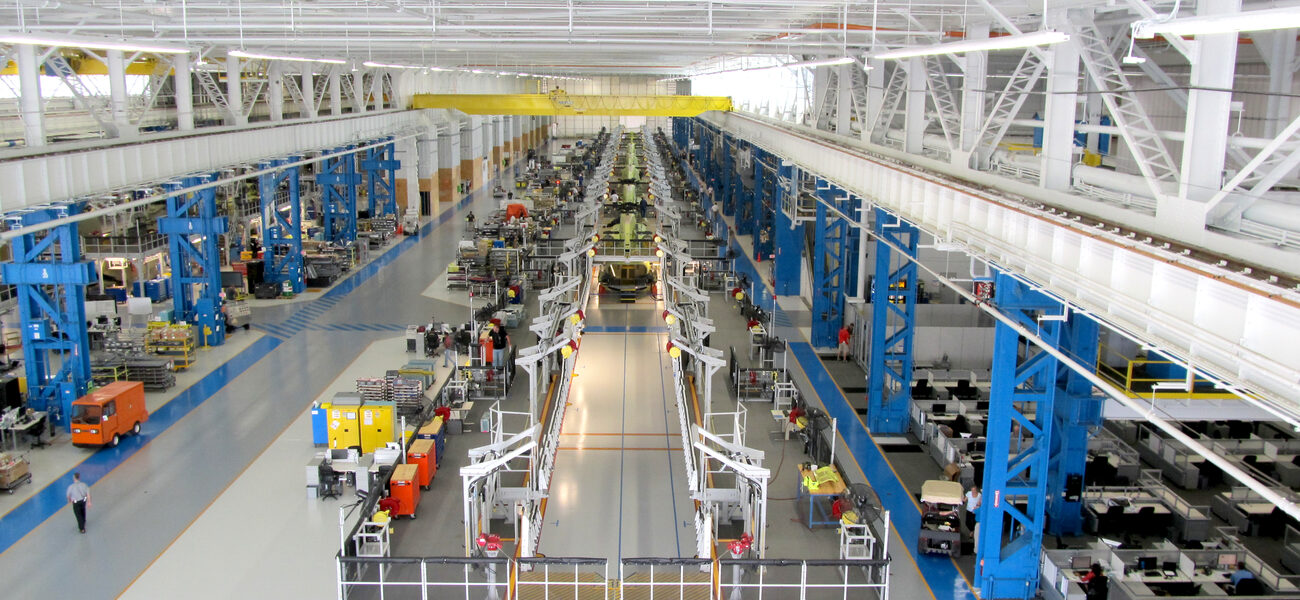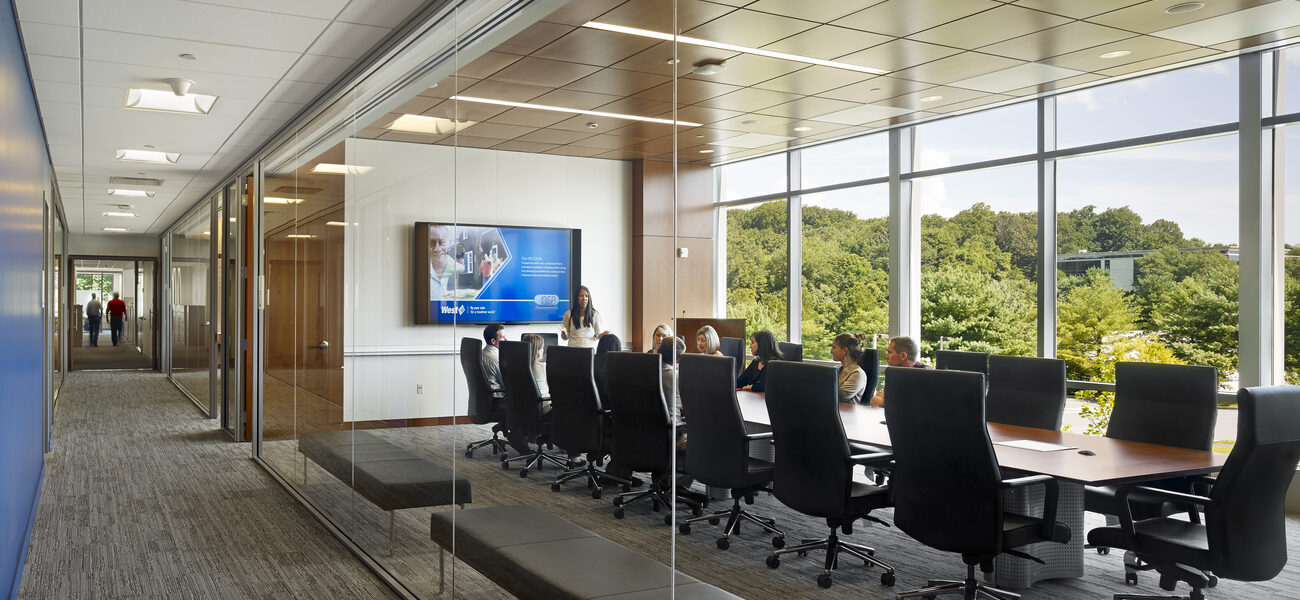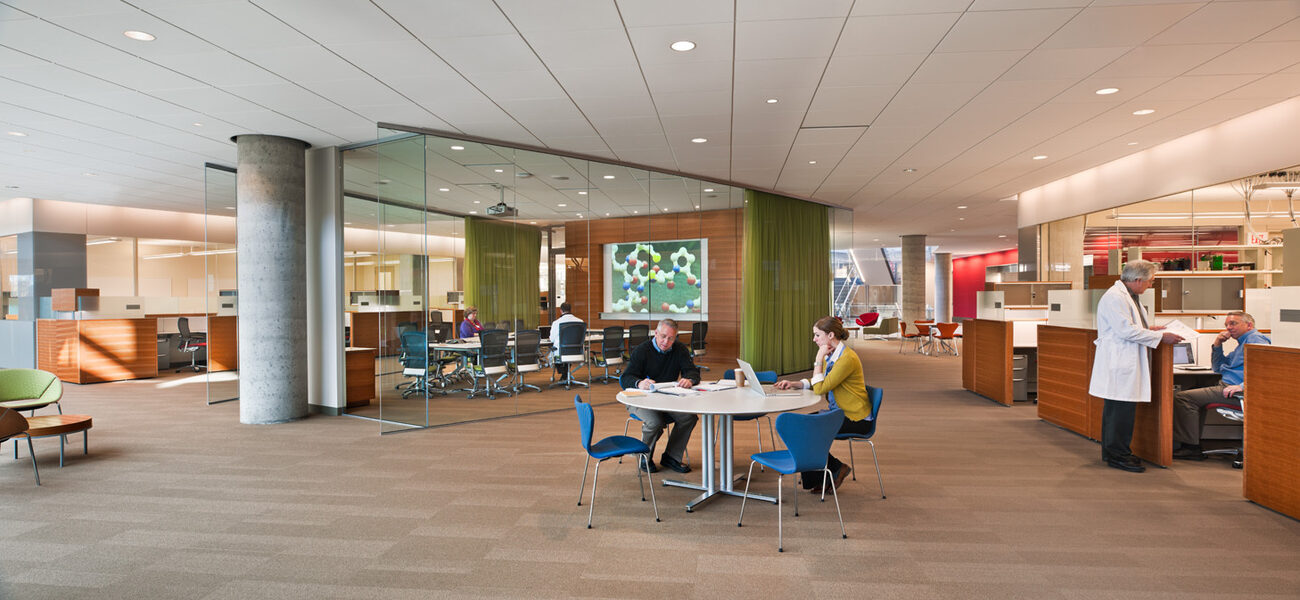Space doesn’t drive an organization’s culture, but when thoughtfully designed, it will enhance and support the work. Culture—the shared set of values, goals, and practices critical to decision making and business success—determines work styles, space, and effectiveness, making it one of the most important drivers of collaborative workplace design for an organization.
“We believe an organization’s culture influences how work is conducted and the type of space required to support the work. Organizational culture drives levels of collaboration and interaction, and is crucial to determining the types of space we need to provide,” says Katherine Ahrens, an interior designer with Ballinger. Based on this theory, Ahrens and Keith Mock, a principal with Ballinger, combine statistics gathered from industry research and publications with their own long-term client research to create a baseline set of workplace metrics. These metrics form a starting point for workplace design based on four key factors influencing collaborative work styles: socialization, mobility, technology and space utilization.
“In the preliminary design phase, we work with clients to understand how they are working in their current space and how they want to work in the future,” says Ahrens. “We call it ‘work-style-focused programming.’ It’s a way to understand the difference between space driving behavior and behavior driving space.” While their metrics are collected through project experience that spans a variety of sectors—including corporate, higher education, and healthcare—they also compare their experience with clients, such as the University of Wisconsin, West Pharmaceutical, Boeing, and Merck & Co., to the topics being presented through industry news and publications.
“Having a file of metrics on a range of clients helps us understand new clients in relationship to work we’ve already done. With minimal information on a new client, we can design a preliminary workplace strategy based on the metrics we’ve established,” says Ahrens.
Key Industry Metrics for Socialization
- 87 percent learn the most through informal interaction. (“Disproving Widespread Myths About Workplace Design.” BOSTI Associates. 2001.)
- 60 percent of the skills employees require to do their jobs are learned informally. (Brand, Jay L. “Facilities Strategies to Support Corporate Change and Flexibility.” Haworth White Paper. Web. September, 2009.)
- 79 percent feel the most important leadership attribute is trustworthiness. (“Leveraging Complexity.” Steelcase 360 magazine, Issue 61. Web. nd.)
For a project at the University of Wisconsin, designing a new building to house the Wisconsin Institute for Discovery and Morgridge Institute for Research (known collectively as the Wisconsin Institutes for Discovery, or WID), Ballinger set up focus groups to determine how staff intended to use the space. One of the significant outcomes was the desire to create a strong community connection. WID’s research space on the three upper floors consists of three lab modules surrounded by open collaborative areas, allowing researchers to easily move between research blocks.
“Each block is secure, but everything else is open, with no enclosed corridors, so they have an open, fluid work environment within the space. They wanted to be integrated without visible boundaries,” says Mock. The ground floor is devoted to amenities serving researchers, students, and the community, including a coffee shop, restaurants, ice cream shop, and a large multifunctional commons area. These community spaces can help socialize the research process and provide numerous outlets for informal interactions and learning, both with the larger community, as well as with research colleagues.
A Boeing helicopter factory Ballinger designed in Pennsylvania provides another example of how social interaction can greatly influence workplace and performance and reinforce culture. The space required a complete redesign to integrate the engineers into the factory and bring them closer to the assembly line. “We reorganized the space and how they set up their groups, with specific metrics to integrate the office environment into the factory. We also looked at how close people should sit to have optimum collaboration,” says Mock.
The project was challenging due to the size of the plant: comparable to 10 football fields. As a starting point, Mock used the Allen curve, a traditional metric stating that workers should be no more than 100 feet (30 meters) apart to promote collaboration. “When we looked at the Boeing facility, that was way too far. You get your highest collaboration within 45 feet if you are working with somebody within a cluster. Once you get beyond 75 feet, collaborative work begins to flatline,” says Mock. Workers at Boeing who need to interact are now no more than 50 feet apart. The new setup has significantly increased efficiency and production at the factory.
In conjunction with social interaction, creating an atmosphere of trustworthiness in the work environment can be difficult to achieve. For a move from leased space into a new headquarters building with lab space, West Pharmaceutical asked Ballinger to design a space that would reflect their desired work culture, which is geared toward the importance of family, collaboration, and team building. “They wanted a space with lots of glass, including the executive suite, which is fully connected to all the other office environments. West’s response to fostering a trusting culture was to create a sense of transparency in their workspace,” says Mock.
Key Industry Metrics of Mobility
- Intel Corporation’s internal research showed 60 percent of their workstations were empty at any given time of day. (“How Emerging Work Strategies are Changing the Workplace.” Steelcase 360 Magazine Deep Dive. Web. June, 2009.)
- 95 percent of employees say they need spaces for focused work; 40 percent say they don’t have them. (“Creating an Interconnected Workplace.” Steelcase 360 Magazine. Issue 63. Web. nd.)
Ballinger initiated an extensive research project with Merck & Co. at their New Jersey headquarters, aimed at evaluating their space planning, metrics, and standards. The Ballinger team designed a 27,000-sf pilot workspace to explore alternative space strategies that could be employed across their global office locations, and evaluated the space over the course of a year. The analysis included multiple evaluation tools and tweaks to the physical space that ultimately lead to a global occupancy planning brief. “They had this area available and were willing to use it to develop metrics and models specific to the way they work and do business,” says Mock. “Having this space set up also helped with change management, because employees could see, touch, and comment on their future workspace.”
Merck’s new office space creates an environment that supports collaborative work and the company’s flexible work program, which offers employees work-from-home options. “We needed to optimize the space and work with these two programs in tandem,” says Ahrens. Based on company-specific metrics used to determine the number of collaborative or multifunctional seats necessary to support employees, Merck starts with a benchmark of providing up to one assigned seat for every collaborative seat, and adjusts this to support the specific user group’s need. “We developed these metrics based on other installations for Merck across their various sites, adjusting the ratios for the new space based on whether the group was highly collaborative or individually focused,” says Ahrens. To create additional metrics for space planning, the Ballinger team surveyed employees about how many days a week they are in the office. While most employees report being in the office 80 to 90 percent of the time, attendance data from ID badges revealed actual in-office hours were significantly lower. This metric supported the decision to reduce the number of one-to-one seating assignments and move to a ratio closer to eight seats for every 10 occupants in certain locations. This lower ratio is supported through alternate seating provisions, such as touchdown seats and work areas that support both interactive and focused work styles.
Increased collaboration and more open-plan work environments generate the need for more focused space. Ballinger has worked with clients such as Merck to understand this balance and how to allocate the right number of spaces for their users. It is important to provide enclosed spaces, such as privacy rooms, that can be used either for focused work or to complete noise-producing work. These spaces can mitigate distractions for colleagues in open-plan environments and offset some acoustic concerns. Merck found through the pilot research process that their ideal ratio of such spaces landed at about one privacy room for every 15 seats. These rooms are only about 80 sf and accommodate one to three people at most. “They’ve found great value by providing privacy rooms in their new working model in order to support open-plan occupants,” says Ahrens.
Key Industry Metrics for Technology and Space Utilization
- 95 percent of employees report email as their preferred collaboration tool. (Kristensen, Dr. Kjetill and Puybaraud, Dr. Marie. “Collaboration 2020: Hype or Competitive Advantage?” Johnson Controls, 2011.)
- Rooms with technology are used five times more often than rooms without. (“What it Takes to Collaborate: Research Summary.” Herman Miller White Paper. Web. 2012.)
- On average, collaborative events are brief. They consist of two to three people and use few tools. (“What it Takes to Collaborate: Research Summary.” Herman Miller White Paper. Web. 2012.)
- High-density layouts produce 84 percent more team member collaborations. (Lessons Learned: Ideas for Creating Harder Working Spaces. Steelcase 360 Magazine. Issue 59. Web. nd.)
In creating new workspaces that supports collaboration, planning for appropriate technology is crucial. Email remains the preferred communication option for most employees, and can be accommodated simply by providing WiFi both indoors and outdoors, says Mock. With outdoor space becoming an accepted part of the work environment, allowing for mobility within the workforce is key. “One of the most important things an employer can do is invest in the right technology. It doesn’t have to be expensive. You may not need a conference room with telepresence capability. Sometimes just putting a monitor in a small privacy room or phone-booth setup maximizes the space utilization,” he says.
In terms of space utilization, it is imperative to understand how users work, and how the physical space can support their activity. For most day-to-day team interactions, group sizes range from two to four people. For these types of meetings, it is essential to provide an adequate number of smaller meeting rooms. “We find this is a trend everywhere. The larger conference rooms are now more remote and fewer in number,” says Mock. He recommends that these smaller rooms not be reservable, which allows for them to be used most effectively. It creates space for less formal teaming exchanges and provides an area to continue ad hoc interactions that may begin as a passing conversation and develop into a longer dialogue, or to conduct last-minute, spontaneous collaborations. “It’s better to have plenty of smaller rooms that are readily available and can accommodate those impromptu meetings,” he says.
Another successful approach to maximizing space utilization is to create multi-purpose space. One method is to locate executive meeting space or boardrooms adjacent to less formal collaborative work areas or shared amenity spaces. At West Pharmaceutical, the executive boardroom is located next to the most open parts of the building. This adjacency makes the space feel more accessible to employees, and encourages its use. The space no longer feels like executive territory. “We encourage the idea of multifunctional space,” says Mock. “We commonly go into corporate facilities and find that space is only used 40 to 60 percent of the time.” Finding the happy medium between space types, quantities, and locations can create a well-utilized model for interactive shared space.
While industry metrics have a role in space planning and designing an appropriate work environment, Mock and Ahrens have found the most important research is client-specific. “There is no one-size-fits-all solution. Collaboration does not automatically mean increased productivity and profitability unless it works for the organization’s culture. Collaborative environments are driven by the physical space and virtual space. Thinking of them in tandem will yield the highest dividends,” says Ahrens.
By Mary Beth Rohde
This article is based on a presentation by Ahrens and Mock at Tradeline’s Space Strategies 2013 conference.


